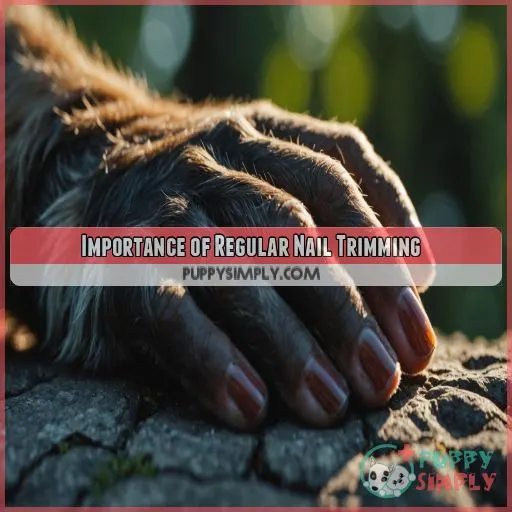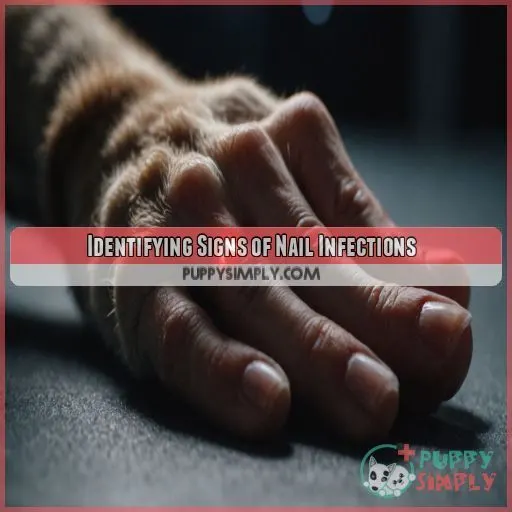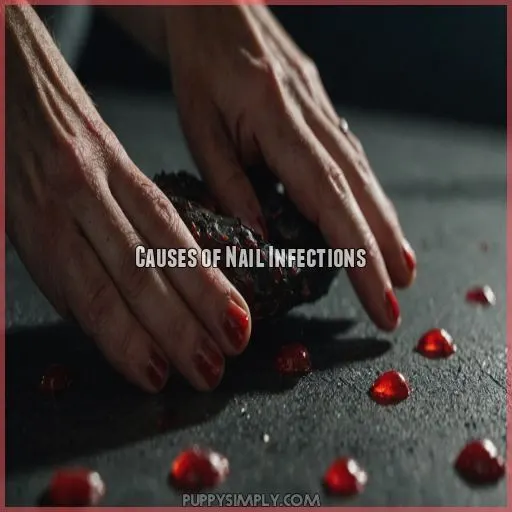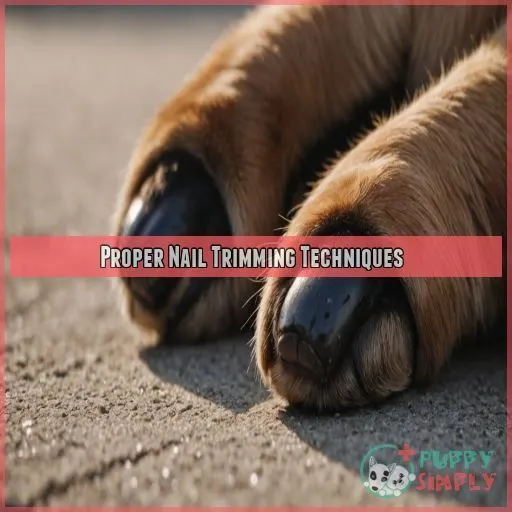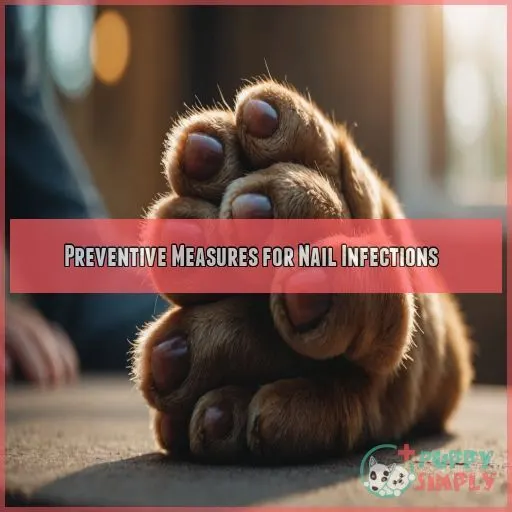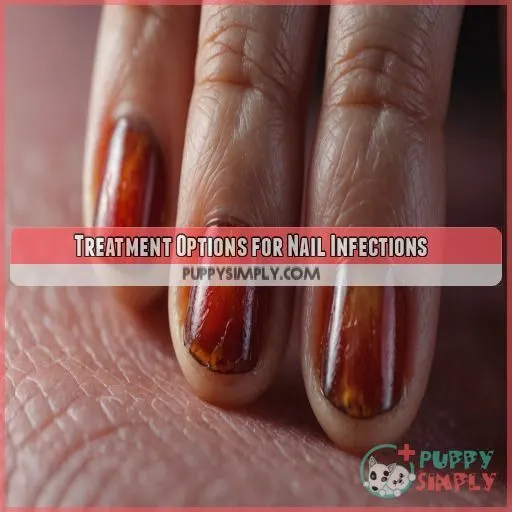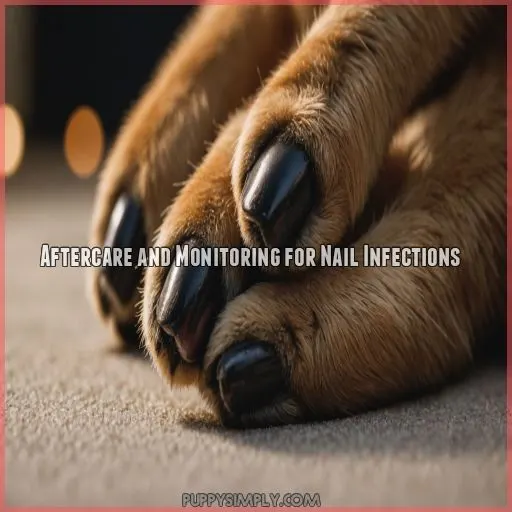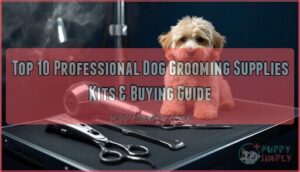This site is supported by our readers. We may earn a commission, at no cost to you, if you purchase through links.
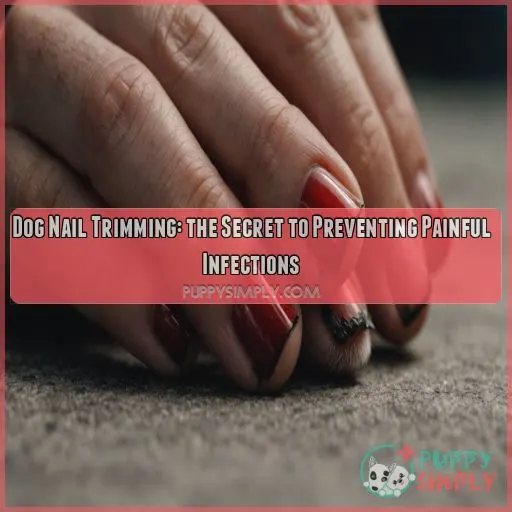 Keeping your furry friend’s nails in tip-top shape isn’t just about looks, it’s a key step in preventing painful infections.
Keeping your furry friend’s nails in tip-top shape isn’t just about looks, it’s a key step in preventing painful infections.
Regular dog nail trimming is your secret weapon against nasty bacteria and fungi.
Think of it as a paw-dicure that keeps your pup healthy and happy!
Aim to trim those little claws every 4-6 weeks, adjusting based on your dog’s breed and lifestyle.
Watch out for signs of trouble like discoloration, swelling, or if your pooch is suddenly doing the "ouchie dance" when walking.
By staying on top of nail care, you’ll prevent infections but also keep your four-legged friend strutting confidently.
And trust us, there’s more to nail care than meets the eye!
Table Of Contents
- Key Takeaways
- Importance of Regular Nail Trimming
- Identifying Signs of Nail Infections
- Causes of Nail Infections
- Proper Nail Trimming Techniques
- Preventive Measures for Nail Infections
- Treatment Options for Nail Infections
- Aftercare and Monitoring for Nail Infections
- Frequently Asked Questions (FAQs)
- How to keep a dog’s nail from getting infected?
- Can a dog get an infection from cutting nails?
- How do you prevent a dog’s broken nail from getting infected?
- How do I condition my dog for nail trimming?
- How often should I trim my dogs nails?
- Can I use human nail clippers for dogs?
- What tools are best for trimming black nails?
- Should I trim dew claws differently than other nails?
- How can I desensitize my dog to nail trimming?
- Conclusion
Key Takeaways
- Stay on top of regular nail trims every 4-6 weeks to prevent painful overgrowth and injuries – it’s like a pawdicure to keep your pup strutting confidently!
- Watch for red flags like discolored, swollen, or painful nails, and don’t hesitate to get your vet involved to nip those pesky nail infections in the bud.
- Use the right tools and techniques – identify the quick, cut at a 45-degree angle, and go slow to keep your furry friend comfortable during nail trims.
- Maintain nail hygiene by cleaning paws after walks, managing any underlying health issues, and protecting those paws from injury – your dog will thank you for the TLC!
Importance of Regular Nail Trimming
Ensuring your dog’s paws stay happy and healthy starts with regular nail trims. Properly maintained nails prevent painful overgrowth and injuries, but they also promote overall foot comfort and mobility, which is why learning about proper nail trimming techniques is important.
Preventing Overgrowth and Injuries
Regular nail trimming is important for preventing painful overgrowth and injuries in your canine companion.
Different dog breeds have varying nail growth rates, so it’s essential to stay on top of those trims every 4-6 weeks.
Investing in high-quality nail clippers and protecting those paws will go a long way in keeping your pup comfortable and safe.
Maintaining Proper Nail Length
Keeping your dog’s nails trimmed to the proper length is important for their comfort and well-being. Overgrown nails can cause pain, disability, and even injuries and can also lead to painful infections.
As a general rule, aim to trim your pup’s nails every 4-6 weeks. This frequency may vary based on your dog’s breed, activity level, and nail growth rate.
Use high-quality nail trimmers designed for dogs to get the job done safely and effectively.
Promoting Foot Health and Comfort
Regular nail trims prevent painful ingrown nails. This simple practice can make a big difference in your dog’s overall health and well-being.
Massaging their paws promotes circulation and relaxation. This can be a great way to bond with your dog and help them unwind.
Occasional dog booties safeguard sensitive paw pads from hot pavement or sharp objects. This can be especially important during the summer months or in areas with rough terrain.
A little TLC for your pup’s feet helps them stay happy and healthy.
Identifying Signs of Nail Infections
Keeping an eye out for the telltale signs of nail infections can help you nip those pesky problems in the bud.
From discolored nails to limping, spotting the red flags early is key to getting your pup the care they need.
Discoloration and Deformities
Yellowish or dark-colored nails can signal underlying issues. Severely thick, crumbly, or misshapen nails are clear red flags.
These nail deformities often accompany infections and may indicate:
- Bacterial or fungal nail infections
- Lupoid onychodystrophy, an autoimmune condition affecting nail growth
- Injury or trauma causing nail malformation
Catching these signs early is key to preventing further complications. Keep a close eye on your pup’s paws.
Inflammation and Discharge
But fret not – a little TLC can get that paw back in tip-top shape.
Keep an eye out for redness, swelling, or any funky-smelling gunk.
A quick visit to the vet can pinpoint the culprit and get your furry friend on the mend.
Lameness and Pain
If your dog starts limping or seems reluctant to put weight on their paw, it could signal a painful nail infection.
Look for these tell-tale signs:
- Favoring one paw over the others
- Whimpering or yelping when you touch their nails
- Refusing to run or play
- Constantly licking or chewing at their paws
Don’t ignore these red flags – address the issue promptly to relieve your pup’s discomfort.
Causes of Nail Infections
Nail infections in dogs can have a variety of culprits.
From bacterial, fungal, and yeast invaders to environmental factors and injuries, there are many potential causes of nail infections in dogs.
But don’t worry, you can outsmart these troublemakers with some smart nail trimming techniques.
Bacterial, Fungal, and Yeast Infections
Most nail infections in dogs stem from three culprits: bacteria, fungi, and yeast. These microscopic troublemakers can wreak havoc on your furry friend’s paws.
Bacterial infections often result from cuts or breaks in the nail, while fungal infections love warm, moist environments.
Yeast infections, on the other hand, can be triggered by allergies or a weakened immune system.
Regular nail trimming and paw checks can help you catch these pesky invaders early on.
Environmental Factors and Injuries
Walking your furry friend through various environments can expose their paws to hidden dangers.
Your dog’s nails are constantly at risk from:
- Rough terrains like rocky paths or concrete sidewalks
- Harsh chemicals used on lawns or sidewalks
- Moisture-rich areas that breed bacteria
These factors can lead to nail trauma or create the perfect breeding ground for infections. Keep an eye out for potential hazards and consider protective booties for your pup during outdoor adventures.
Underlying Health Conditions
Your furry friend’s health can play a sneaky role in nail infections. Allergies, diabetes, and a weakened immune system can make your pup more susceptible.
Autoimmune diseases and hormonal imbalances might also be culprits. It’s like your dog’s body is throwing a curveball, making it harder to fight off pesky nail invaders.
Regular check-ups and proper dog nail trimming find the right vet are your best defense against these underlying troublemakers.
Proper Nail Trimming Techniques
Proper nail trimming isn’t just about keeping your pup’s paws looking neat, it’s a key step in preventing painful infections.
Let’s explore some easy techniques that’ll help you become a pro at this important task, keeping your furry friend’s nails healthy and infection-free.
Gradual Desensitization and Positive Reinforcement
Dogs can develop anxiety about nail trims due to past negative experiences. To ease their fears, try gradual desensitization and positive reinforcement.
Here’s a simple approach to help your dog feel more comfortable with nail trims:
- Touch your dog’s paws daily, rewarding with treats
- Introduce nail clippers slowly, pairing with treats
- Start by trimming one nail, followed by lots of praise
- Gradually increase the number of nails trimmed per session
This patient process creates a positive association, turning nail care into a stress-free experience for both you and your furry friend.
Proper Tool Selection and Maintenance
For successful nail trimming, choose the right tools and keep them in top shape.
Consider using nail clippers designed for your dog’s size or opt for a grinder for smoother results.
Just like a chef sharpens their knives, you’ll want to maintain your grooming tools. This is crucial for happier paws.
Clean and sterilize them after each use to prevent the spread of infections.
Safe and Effective Cutting Angles
When it comes to cutting your pup’s nails, you want to get it just right. It’s like giving them a manicure.
Identifying the Quick
To start, you need to identify the quick (the pink part) and cut at a 45-degree angle.
Cutting Techniques
Here are some tips to keep in mind:
- Snip small amounts at a time to avoid over-trimming.
- For dark nails, look for the chalky ring inside – that’s your stopping point.
Preventive Measures for Nail Infections
Keeping your furry friend’s nails in tip-top shape isn’t just about looks, it’s a really important step in preventing painful infections.
Let’s explore some simple yet effective ways to shield your pup’s paws from pesky nail problems, so you can both enjoy more worry-free walks and playtime.
Maintaining Proper Nail Hygiene
You’ve mastered the art of trimming your pup’s nails, but keeping them clean is equally important.
Nail hygiene is just as important as trimming.
Invest in quality nail hygiene tools and establish a routine that fits your dog’s nail growth patterns.
Different breeds may require more frequent attention.
After walks, give those paws a quick once-over to remove dirt and debris.
It’s like giving your furry friend a mini-pedicure – they might even learn to enjoy it!
Managing Underlying Health Issues
Nail infections in your furry friend can be caused by a few key health issues.
Allergies can lead to excessive paw licking, which can irritate the skin and make it more susceptible to infection.
A balanced diet is crucial for boosting your dog’s immune system, helping them fight off infections.
Don’t forget about dental health! Regular teeth cleaning can prevent bacteria from spreading to the paws.
Protecting Nails From Injury
- Provide soft dog toys for playtime
- Avoid walking on rough surfaces
- Use nail guards during outdoor adventures
- Apply paw balm before winter salt exposure
Treatment Options for Nail Infections
If your furry friend’s paws are looking a bit worse for wear, don’t panic just yet.
Let’s explore some effective treatment options that’ll have your pup’s nails back in tip-top shape and help prevent future infections.
Topical Medications and Ointments
If your pup has a nail infection, topical medications and ointments can be a game-changer.
These easy-to-apply solutions pack a punch against pesky bacteria and fungi.
From antifungal creams to antibacterial sprays, you’ve got options.
Just remember, consistency is key – apply as directed for best results.
While over-the-counter remedies can help, don’t hesitate to consult your vet for prescription-strength solutions if needed.
Oral Antibiotics or Antifungals
Sometimes, topical treatments just don’t cut it.
Your vet might prescribe oral antibiotics or antifungals to tackle those stubborn nail infections from the inside out.
These medications pack a powerful punch, but they’re not without their quirks.
Here’s what you need to know:
- Dosage: Follow your vet’s instructions to a T.
- Duration: Stick to the full course, even if symptoms improve.
- Side effects: Keep an eye out for tummy troubles or allergic reactions.
Surgical Intervention in Severe Cases
In severe cases, where other treatments haven’t worked, your vet might recommend toe amputation. It’s a last resort, but sometimes necessary to prevent the infection from spreading.
Here’s what you need to know about the process:
| Stage | Action | Recovery Time |
|---|---|---|
| Pre-op | Antibiotics | 1-2 weeks |
| Surgery | Amputation | 1-2 hours |
| Post-op | Rest & care | 2-4 weeks |
Don’t worry, dogs adapt quickly, and with proper care, they’ll be back on their paws in no time!
Aftercare and Monitoring for Nail Infections
You’ve treated your pup’s nail infection, but the battle isn’t over yet. Proper aftercare and careful monitoring are key to keeping your furry friend’s paws healthy and infection-free.
Maintaining a Clean and Dry Environment
Now that you’ve treated your pup’s nail infection, it’s time to play defense.
Keep those paws squeaky clean and dry as a bone!
After walks, give ’em a quick wipe-down with antibacterial wipes.
Got a water-loving pooch? No problem! Just make sure to thoroughly dry those tootsies after splashing around.
Monitoring for Recurrence or Spreading
After keeping your pup’s paws clean and dry, you’ll want to keep a watchful eye out for any signs of trouble.
Don’t let your guard down!
Look for redness, swelling, or discharge around the nail bed.
If you spot these warning signs, it’s time to spring into action.
Incorporating Regular Veterinary Checkups
Regular vet checkups are key for your pup’s nail health.
Schedule visits every 6-12 months to catch potential issues early.
Your vet can assess nail trim frequency and recommend vet-approved products.
They’ll also keep an eye out for any nail health concerns, ensuring your furry friend stays on their toes.
Frequently Asked Questions (FAQs)
How to keep a dog’s nail from getting infected?
Keep your pup’s nails trimmed regularly to avoid painful infections.
Use a gentle touch, and don’t cut too short.
If you spot any redness or swelling, get your vet involved right away for proper treatment.
Can a dog get an infection from cutting nails?
A dog can definitely get an infection from improperly cutting their nails.
Always use the right tools, trim carefully, and consult your vet if you notice any redness, swelling, or other signs of trouble.
It’s better to be safe than sorry.
How do you prevent a dog’s broken nail from getting infected?
Cracked or broken nails are like a doorway for pesky germs – don’t let ’em crash the party!
Quickly clean the area to prevent any unwanted nail infection drama.
Apply an antibiotic ointment to help keep the area clean and prevent infection.
Keep a watchful eye on the area to make sure the infection doesn’t spread.
How do I condition my dog for nail trimming?
Ease your pup into nail trims gradually.
Start by gently handling their paws.
Then, move to clipping a single nail, praising and rewarding them along the way.
Building their trust will make the process a breeze for both of you.
How often should I trim my dogs nails?
Keeping your pup’s nails trimmed is a cinch.
Aim for every 4-6 weeks to stay ahead of the curve.
Snip those claws like a pro and give your furry friend a spring in their step.
Can I use human nail clippers for dogs?
Human nail clippers aren’t the best choice for your dog.
They’re not designed for a dog’s thicker nails.
Using human nail clippers could cause more harm than good.
It’s best to use specialized dog nail trimmers to keep your pup safe and comfortable when trimming their nails.
What tools are best for trimming black nails?
Trimming ebony nails can be a tricky task.
But fear not!
Grab a pair of sturdy dog nail clippers.
They’re precisely engineered to handle even the toughest talons with ease.
Clip with confidence, and your pup’s paws will be picture-perfect in no time.
Should I trim dew claws differently than other nails?
You’ll want to trim dew claws a bit differently – they’re more sensitive and tend to grow thicker.
Dew claws are more sensitive and tend to grow thicker.
Take extra care when clipping them to avoid cutting too deep and causing pain or bleeding.
Go slow and be gentle.
How can I desensitize my dog to nail trimming?
Rome wasn’t built in a day, and desensitizing your pup to nail trims takes patience.
Start slow, shower them with praise and treats, and before you know it, they’ll be as cool as a cucumber.
Conclusion
Dog nail trimming is a small but mighty task that pays big dividends for your pup’s health and happiness, especially when you learn how to do it safely and painlessly.
By staying on top of regular trims, you can keep your canine companion strutting confidently.
Nail care may not be the most glamorous part of pet ownership, but it’s a dog-gone important piece of the puzzle for preventing painful infections.
You should also recognize the signs of nail infections to avoid the pain and discomfort of nasty nail issues.

